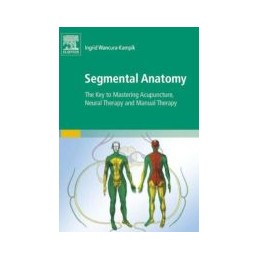- Obniżka


 Dostawa
Dostawa
Wybierz Paczkomat Inpost, Orlen Paczkę, DHL, DPD, Pocztę, email (dla ebooków). Kliknij po więcej
 Płatność
Płatność
Zapłać szybkim przelewem, kartą płatniczą lub za pobraniem. Kliknij po więcej szczegółów
 Zwroty
Zwroty
Jeżeli jesteś konsumentem możesz zwrócić towar w ciągu 14 dni*. Kliknij po więcej szczegółów
Formidably illustrated and written, the correlations between spinal nerves and segments in skin, musclar system and bones as well as the projection areas of internal organs on the body surface area are deduced from the anatomy of the nervous system.
These correlations between spinal nerves and the periphery of the body explain how acupuncture, neural, and manual therapies take effect .
Great accessibility through::
Opis
1
Segmentation and Metamerism 1
What is a Segment? 1
The Significance of Segments 7
2
The Role of the Peripheral Spinal Nervous System in Segmentation 1
The Spinal Nerves 4
The Branches of the Spinal Nerves 15
The Three Spinal Nerve Branches As the Basis of the Threefold Longitudinal Division of the Body Surface 18
The Branches of the Spinal Nerves in Detail 32
The Dorsal Branches of the Spinal Nerves 32
The Dorsal Branches in Psychosomatic Medicine and Evolution 37
The Ventral and Lateral Spinal Nerve Branches and Plexuses 41
Plexus Formation from the Point of View of Segmental Anatomy 42
The Individual Plexuses 47
The Pre- and Postaxial Lines, Basis of the Meridian-Lines 70
3
The Role of the Peripheral Autonomic Nervous System in Segmental Theory 1
Anatomy 2
The Peripheral Sympathetic Nervous System and Its Role in Segmental Theory 4
The Origins of the Sympathetic Nervous System 5
Sympathetic Innervation of the Limbs 6
Sympathetic Effects on the Dilator Pupillae Muscle and on the Effector Organs of the Integument 7
Sympathetic Supply to the Head, Neck, and Limbs 10
The Efferent Sympathetic Nerves 12
The Afferent Sympathetic Nerve Pathways 33
The Large Sympathetic Ganglia and Their Projections onto the Skin 38
The Peripheral Parasympathetic Nervous System and Its Role in Segmental Theory 46
4
The Dermatomes 1
Radicular Innervation of the Integument 1
Clinical Relevance 2
Parts of a Dermatome 4
The Sensory and Autonomic-Motoric Dermatomes 6
Sensory Dermatomes 6
Autonomic-Motoric Dermatomes 8
Physiological Hyperesthesia 9
The Maximum Points of the Dermatomes 9
The Maximum Areas of the Dermatomes 13
The Hiatus Lines 14
Individual Dermatome Groups, Extent and Shape, Interactions, and Autonomic Facial Expression 17
Dermatomes of the Head and Neck 17
Dermatomes of the Trunk T1 to T12 25
The Lumbar and Sacral Dermatomes 29
Dermatoses and Segmentation 30
5
The Myotomes 1
Radicular Innervation of the Muscles 1
Metameric Order of the Myotomes 2
Herringhams Rules of Location and Distribution of Myotomes in the Muscles 3
The Muscles of the Upper and Lower Limbs and Their Corresponding Myotomes 6
The Individual Myotome Groups 7
The Cervical Myotomes 7
The Thoracic Myotomes (T 1 to T 12) 24
The Lumbo-Sacral Myotomes 34
6
The Sclerotomes 1
Radicular Innervation of the Bones 1
The Spinal Column and Its Segmental Relations 4
The Individual Sclerotomes 6
The Sclerotomes of the Upper Limb and the Shoulder Girdle 6
The Sclerotomes of the Lower Limb and the Pelvis 8
7
The Enterotomes 1
Transformation of Internal Organs into Enterotomes 4
8
Conduction of Impulses Betweeen Segments* 1
Multisynaptic, Proprioceptive, and Viscerogenic Reflexes 1
9
Referred Pain 1
Pain Projected to the Body Surface in Visceral Disease 1
Projected Symptoms 4
On the Location of Projected Symptoms 9
Clinical Significance of Projected Symptoms 9
Algetic Symptoms 10
Hyperalgesia and Hyperesthesia of the Cutis and Subcutis (Head Zones) 12
Hyperalgia of Muscles and Tendons (Mackenzie Zones) 14
Comparison of Pseudoradicular Syndromes, e.g., Radiation of Pain from a Joint Capsule (Fig. 9.4) and Referred Pain (Fig. 9.3) 18
Autonomic-Reflexive Symptoms 21
Autonomic Effects in the Integument 22
Effects on the Head 27
Effects in the Shoulder 35
Asymmetry of Posture and Movement 36
Reflexive and Algetic Spinal Column Syndromes 37
Asymmetry of Proprioceptive and Multisynaptic Reflexes 38
Autonomic Organ Reflexes (Viscero-Visceral-Reflexes) 40
10
The Visceral Organs-the Enterotomes from the Viewpoint of Segmental Anatomy 1
Interactions and Projectional Phenomena 1
The Heart: Algetic and Autonomic-Reflexive Areas of Projection 2
Lungs and Bronchi: Their Algetic and Autonomic-Reflexive Projectional Fields 14
The Esophagus: Algetic and Autonomic-Reflexive Projectional Fields 21
Stomach and Duodenum 26
Small Intestine (Jejunum, Ileum) 32
Cecum, Appendix, Ascending and Transverse Colon 34
Descending Colon, Sigmoid Colon, and Rectum 37
Kidney, Bladder, Ureter-Their Algetic and Autonomic-Reflexive Projectional Fields 41
The Genital Tract: Its Algetic and Autonomic-Reflexive Projectional Fields 47
Testes, Uterus, Ovaries: Their Algetic and Autonomic-Reflexive Projectional Fields 50
Prostate Gland: Its Algetic and Autonomic- Reflexive Projectional Fields 51
Liver and Gallbladder: Algetic and Autonomic-Reflexive Projectional Fields 53
Pancreas and Spleen: Their Algetic and Autonomic-Reflexive Projectional Fields 57
Occurrence of Reflexive and Algetic Symptoms in Other Disorders 58
Indeks: 69038
Autor: Nancy B. Swigert
Indeks: 17687
Autor: red. wyd. pol. Marcin Szkolnicki
